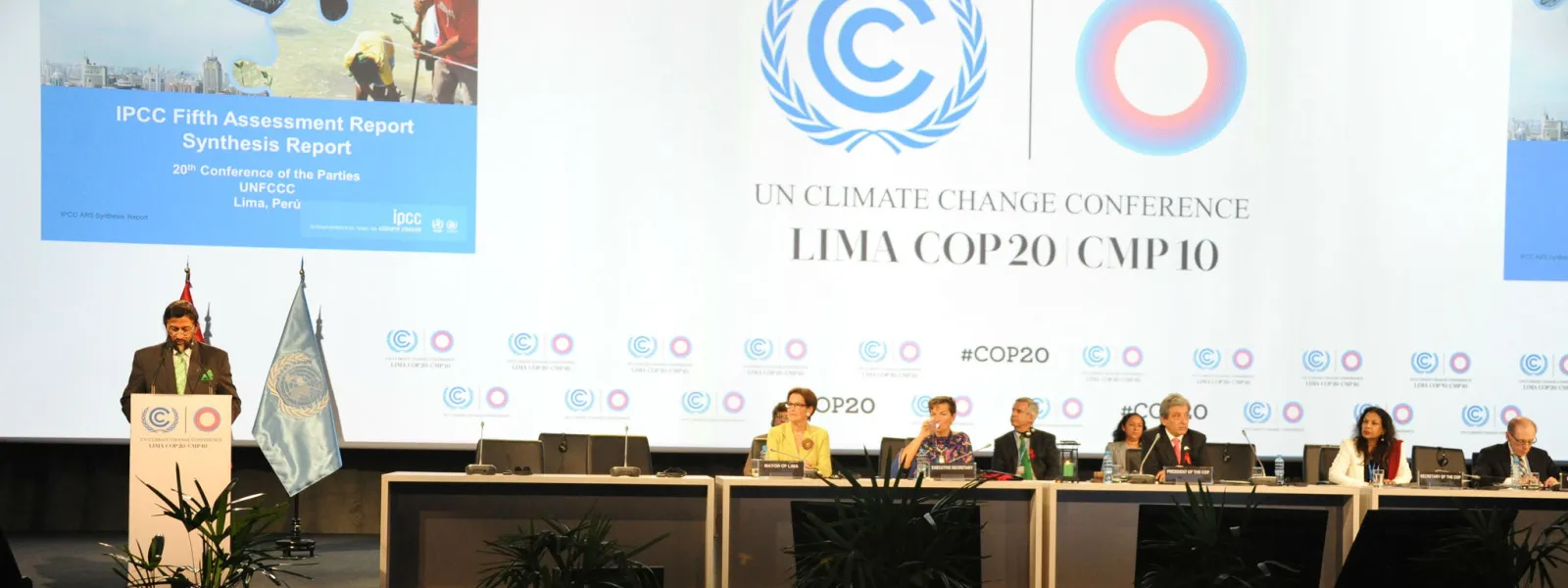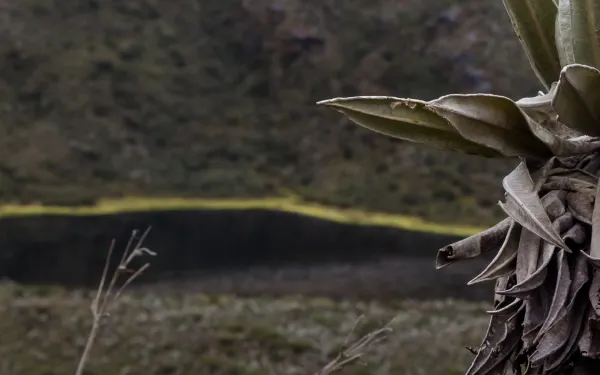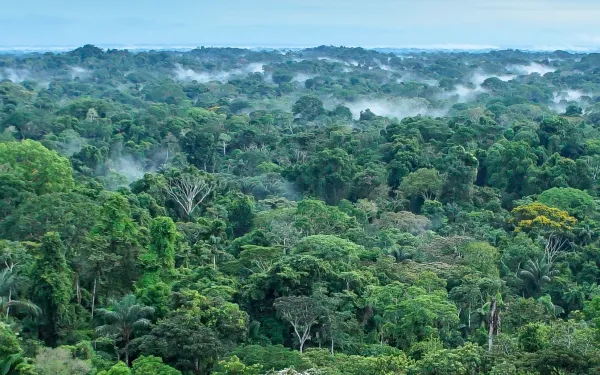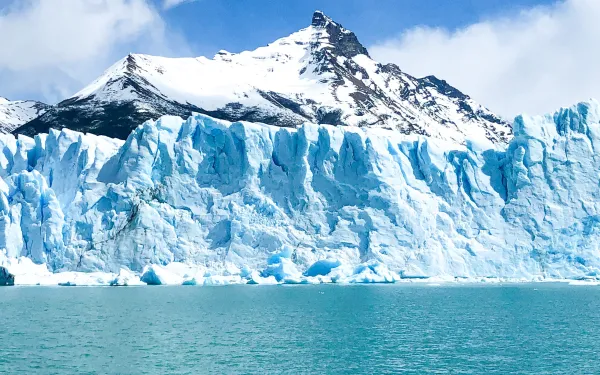
Project
Photo: UNFCCCMonitoring the UN Climate Negotiations
As changes in climate become more extreme, their affects are being hardest felt throughout developing countries. Since 1994, the United Nations Framework Convention on Climate Change has laid out actions to limit the increase of global average temperatures and confront the impacts of climate change.
The States that are Parties to the Convention meet every year in the so-called Conference of the Parties (COP) to review their commitments, the progress made in fulfilling them, and pending challenges in the global fight against the climate crisis.
At COP21 in 2015, they adopted the Paris Agreement, which seeks to strengthen the global response to the climate emergency, establishing a common framework for all countries to work on the basis of their capacities and through the presentation of Nationally Determined Contributions (NDC) that will:
- Limit the increase in global temperatures to 2°C compared to pre-industrial levels and continue efforts to limit it to 1.5°C;
- Increase the capacity of countries to adapt to the impacts of climate change; and
- Ensure that financing responds to the goal of reducing greenhouse gas emissions.
Our focus areas
THE CLIMATE CRISIS AND HUMAN RIGHTS
The climate crisis, due to its transversal character, has repercussions in various fields, geographies, contexts and people. In this regard, the Preamble to the Paris Agreement states that it is the obligation of States to "respect, promote and fulfill their respective obligations on human rights, the right to health, the rights of indigenous peoples, local communities, migrants, children, persons with disabilities and people in vulnerable situations and the right to development, as well as gender equality, the empowerment of women and intergenerational equity."
AIDA at the COP
COP25: Chile-Madrid 2019
At COP25 in Madrid, Spain, we advocated for the inclusion of the human rights perspective in various agenda items. We promoted the incorporation of broad socio-environmental safeguards in the regulation of Article 6 of the Paris Agreement, which refers to carbon markets. We closely followed the adoption of the Gender Action Plan, as well as the Santiago Network, created "to catalyze technical assistance […] in developing countries that are particularly vulnerable to the adverse affects of climate change." We also encouraged the inclusion of ambitious and measurable targets for the reduction of short-lived climate pollutants in the climate commitments of States.
Related projects

Report of the International Mission to Colombia: Stop investor-state dispute settlement (ISDS)
In May 2023, a delegation of 13 representatives from social and environmental justice organisations from eight countries in the Americas and Europe visited Colombia to share experiences of struggles against the global investment protection regime. The mission also went to learn firsthand about the peoples and ecosystems being threatened by corporate lawsuits, as well as the environmental, social and cultural harms that transnational investments have already caused, particularly in the departments of La Guajira and Santander.The visit came in response to the significant rise in claims that transnational firms have made against the country in recent years, as highlighted in the Declaration “Recover Colombian Sovereignty in Defense of Water, Life and Territories”, signed by more than 280 organisations from 30 countries as well as 54 Colombian members of Congress. In the last five years, Colombia has faced some of the highest number of arbitration claims in Latin America. In 2018 alone, Colombia received more claims than any other country in the world.Colombia’s pending claims currently total US$13.2 billion – equivalent to 13% of the nation’s budget for 2023 and nearly equal to what Colombia plans to spend on education this year.According to the State National Agency for Legal Defense, as of March 2023, 14 arbitration processes were underway with eight more in the pre-arbitration stage. Colombia’s pending claims currently total US$13.2 billion (52 trillion Colombian pesos as of August 2023), although in three cases the amount claimed is not public. This is equivalent to 13% of the nation’s budget for 2023 and nearly equal to what Colombia plans to spend on education this year.The bulk of investors that have brought arbitration cases are involved in the extractive industries, especially mining.We witnessed how this system enables corporate impunity and threatens the realisation and defence of Colombians’ fundamental human and environmental rights. We also observed how this system interferes with judicial independence, environmental regulation, and national sovereignty. Read and download the report
Read more
Protecting Ecuador’s Yasuní National Park can bolster the global just energy transition
What the people of Ecuador decide in an August 20 referendum has the potential to not only slow oil exploitation in the Amazon, but also to generate a transformative impact at the national and international levels, recognizing the value of the key ecosystem for stabilizing the global climate and the need to transition to renewable and sustainable energy production. On August 20, in a popular consultation, the Ecuadorian people will have the opportunity to decide on a definitive halt to oil exploitation in a part of Yasuní National Park, one of the most biodiverse areas of the planet, located in the Amazon rainforest. The consultation seeks to stop oil extraction in the ITT block (Ishpingo, Tiputini, Tambococha), one of three in production within the park. Yasuní National Park is a UNESCO Biosphere Reserve. Multiple scientific studies have demonstrated its value in terms of biodiversity and its significance as the home to the Waorani people, and to the Tagaeri and Taromenane indigenous groups in voluntary isolation. The Amazon is an interconnected region shared by eight countries—Bolivia, Brazil, Colombia, Ecuador, Guyana, Peru, Suriname and Venezuela—and by French Guiana, a French overseas department, and what happens in one part of it affects the rest. Moreover, as a megadiverse region that serves as a global climate stabilizer, the importance of the Amazon rainforest is global. The eyes of the world will be watching to see if Ecuador chooses to protect its Amazonian territory, which would have a transformative impact not only in the country, but also across Latin America and the world. Protecting Yasuní would send a clear message that recognizes the ecological and social value of the Amazon to materialize the necessary energy transition and the protection of human rights. Javier Dávalos, AIDA's Climate Program Coordinator and Ecuadorian attorney, reflects: "After years of relentless struggle by social organizations and indigenous movements, Ecuador has the chance to make important progress in protecting an ecosystem that is key to adapting to and mitigating the global climate crisis, as well as to the survival of traditional and indigenous peoples, including those in voluntary isolation. To protect the climate for this and future generations, fossil fuel production must begin to decline immediately, and renewable energy production must be accelerated as part of a just transition. Ecuador can be a pioneer, leaving behind the environmental and social sacrifice zones promoted by the fossil fuel industry and showing the world how civil society can promote the just energy transition that the world needs. It can be an example of how to build energy alternatives based on guaranteeing human rights and the rights of nature, and how to effectively combat the triple crisis the world is facing: climate change, biodiversity loss and pollution." Context The initiative to put a definitive stop to oil exploitation in part of the Amazon is in line with the recommendations of the Intergovernmental Panel on Climate Change and the International Energy Agency that one-third to two-thirds of oil reserves be left in the ground in order to keep the increase in the average temperature of the planet below 2°C, compared to pre-industrial levels, and thus avoid catastrophic effects. The popular consultation in Ecuador takes place a few weeks after the UN Secretary General, Antonio Guterres, declared the beginning of the era of "climate boiling", pointing out the need for concrete changes to face the emergency and crisis caused by global warming. In addition, this consultation comes shortly after the conclusion of the Amazon Summit in Brazil, where the eight Amazonian countries discussed how to chart a sustainable path forward for the Amazon rainforest. "It is time to phase out fossil fuels to protect the Amazon," said Gustavo Petro, President of Colombia, who recently urged Amazonian countries and their partners in the Global North to commit to phasing out fossil fuel exploitation in order to protect the right to a just transition and accelerate the transition to a post-oil economy. press contact: Víctor Quintanilla (Mexico), AIDA, [email protected], +521 5570522107
Read more
Climate Litigation Platform for Latin America and the Caribbean: The road traveled
When the world was in a health crisis and COVID-19 made us turn away from everything and everyone, I came across the Climate Litigation Community of Practice in Latin America. In those days of 2020, I was an external collaborator for Greenpeace Mexico, and I was lucky enough to meet Javier, Florencia, and Veronica, who hosted this nascent community from their roles at AIDA. The community facilitated several virtual meetings to share ideas on climate litigation with people from all over the region concerned about the environment, the climate crisis, and the health of the planet and living beings. We affirmed our shared concerns and showed how we were addressing the environmental and social crises from each of our trenches, using strategic climate litigation. Some people were litigating against deforestation, coal mines, and thermoelectric power plants, or for the inclusion of climate change variables in environmental impact studies. Others were trying to stop fossil fuel policies or to improve and meet national climate commitments. It was interesting to see the breadth and versatility of how litigation is being used to advance climate action. AIDA then invited us to a series of meetings with the protagonists of some of the world's most emblematic strategic litigation cases. The experience of being in close contact with these people, in a space of trust, was unparalleled. It certainly reinforced my belief in the importance of the struggle being waged and the need to learn more about climate litigation. Then came another invitation from AIDA, this time to participate in the Advisory Committee to build a platform that would bring together in one place the cases of climate litigation in our region and in our language, as testimonies of a resistance that comes from many different fronts. The goal was to create a website where users could access information, find arguments to support the struggles, develop strategies, and have the possibility of contacting attorneys and academics. All to make visible the efforts of Latin America and the Caribbean in the face of climate conflicts. The Alana Institute of Brazil, the Foundation for Environment and Natural Resources of Argentina, the Office of the Environmental Ombudsman of Chile, and Greenpeace Mexico responded to the call to participate in the design of the tool. The collaborative efforts bore fruit, and in February 2022, the Climate Litigation Platform for Latin America and the Caribbean was officially born, with the goal of strengthening climate litigation in the region, and with it its power to promote the structural changes that are needed. The main challenge was how to collect, systematize, and update the data. The solution was to create a team of rapporteurs. Thus, volunteers—attorneys or law students from different countries with an interest in environmental, climate and human rights advocacy—began to work together virtually to maintain and update the platform and report new cases in their jurisdictions. The Platform started with 49 cases, and currently hosts 61 cases from eight countries. Another 30 are in the process of being added. The cases are identified and categorized in a user-friendly and intuitive way. The team of rapporteurs consists of 24 people from 12 countries. Without their tireless work and enthusiasm, the platform would not be possible. A year and a half after the launch of the Platform, and much longer since its inception, my memories point to the enthusiasm, dedication and commitment of many people to defend our common home, fight against devastation, and the possibility of bequeathing a greener and bluer planet to the future. We have a responsibility to future generations. We must provide tools, initiate and continue actions that will guide future legal actions to protect and care for the environment. I share with you my conviction that the goals set by the Community of Practice at its first meetings in 2020 will be achieved and that this project will continue to move forward by leaps and bounds. The challenge remains: to continue to share the success stories, the valuable lessons learned when things do not go as we expect, the successful regional and international experiences; and to continue to work to make effective the decisions that give reason to the planet. From AIDA, we invite you to learn about and use the Climate Litigation Platform for Latin America and the Caribbean to enter the world of climate litigation, which represents a great opportunity in the fight for climate justice and the protection of human rights in the region and the world. Visit the platform
Read more